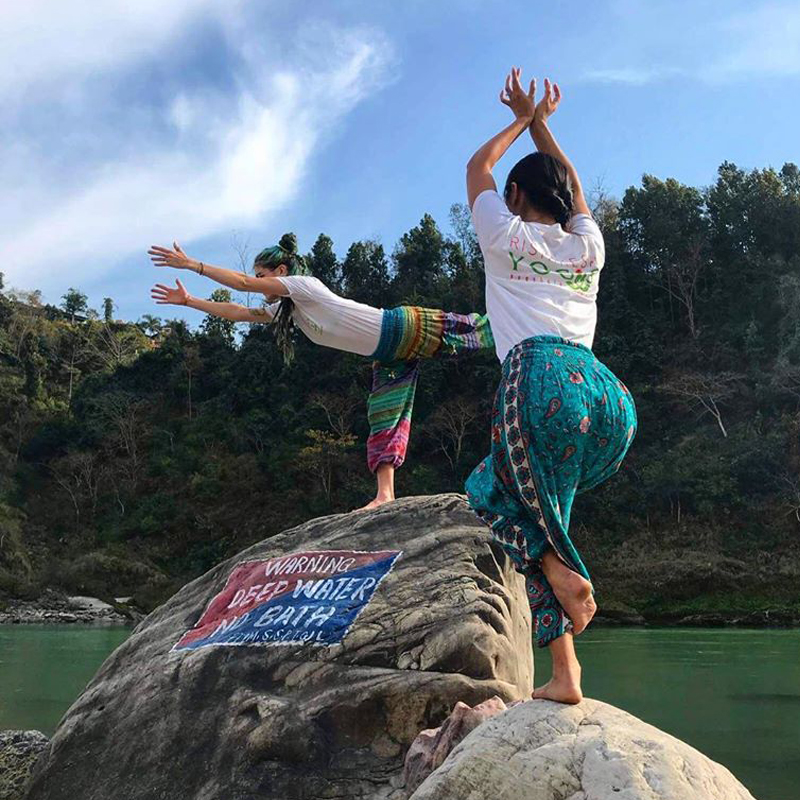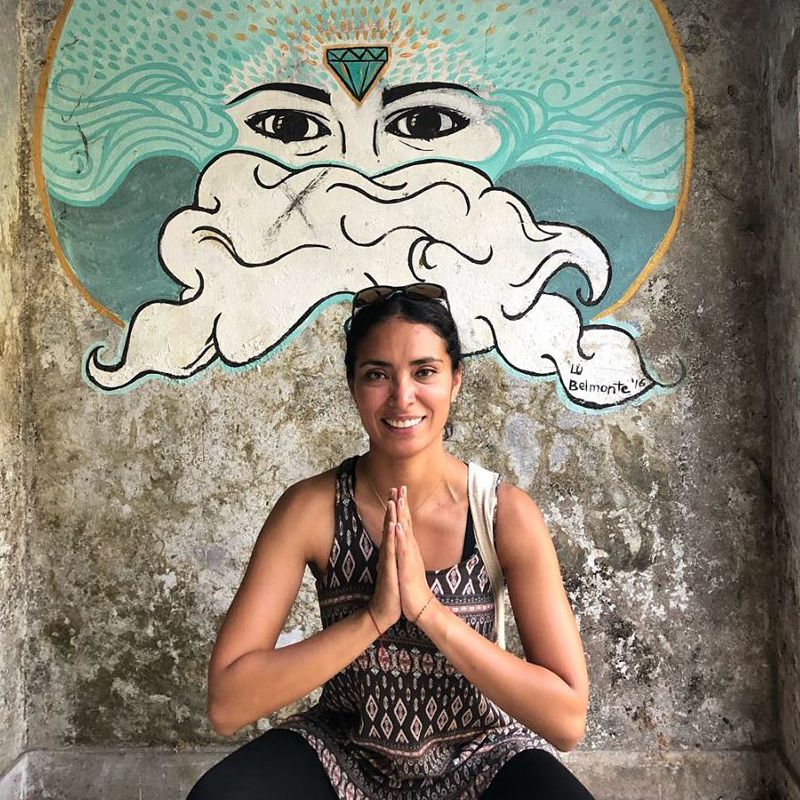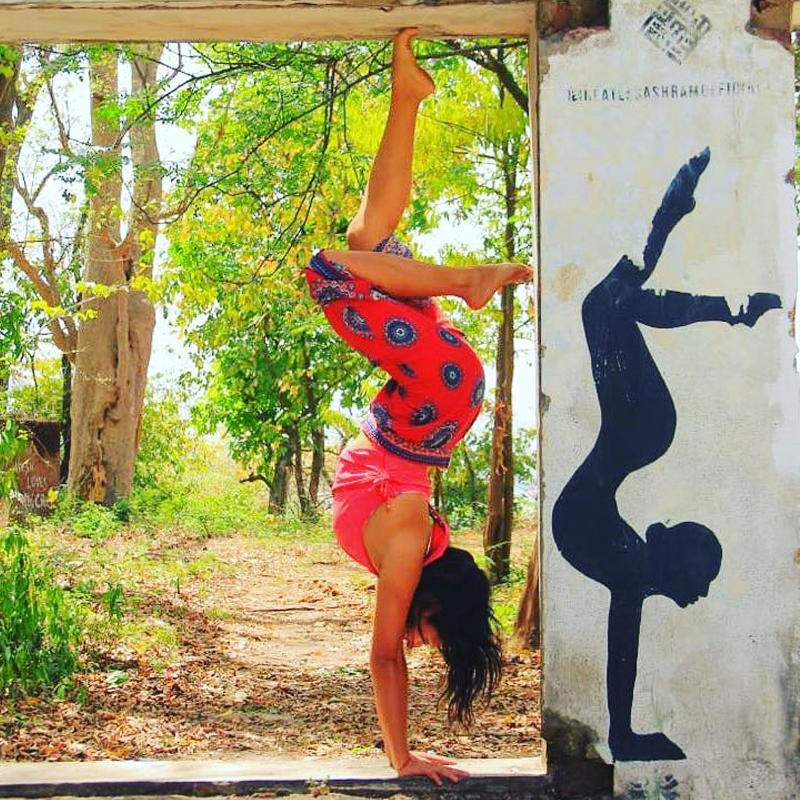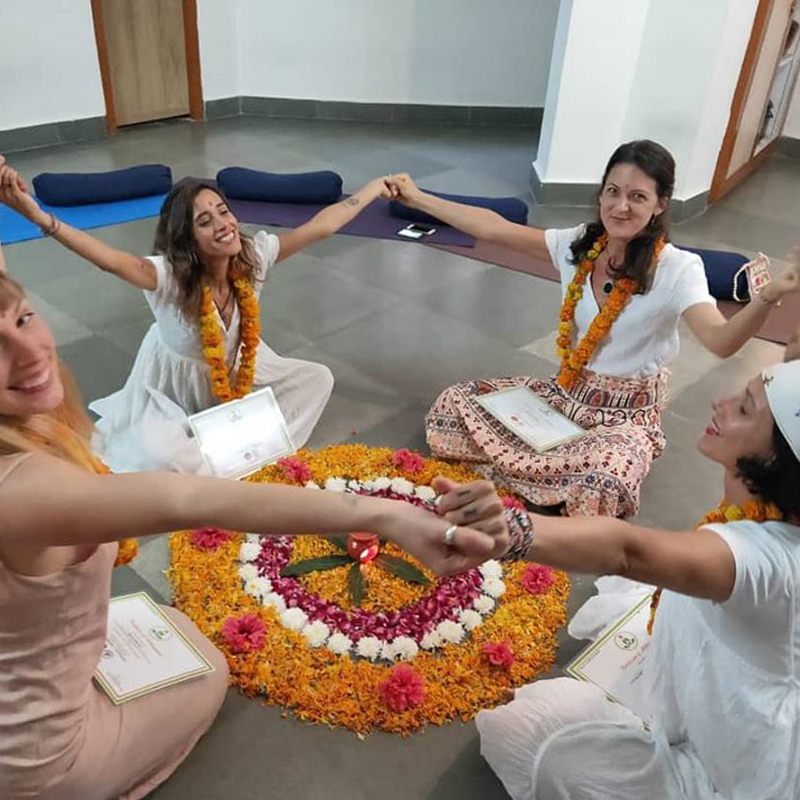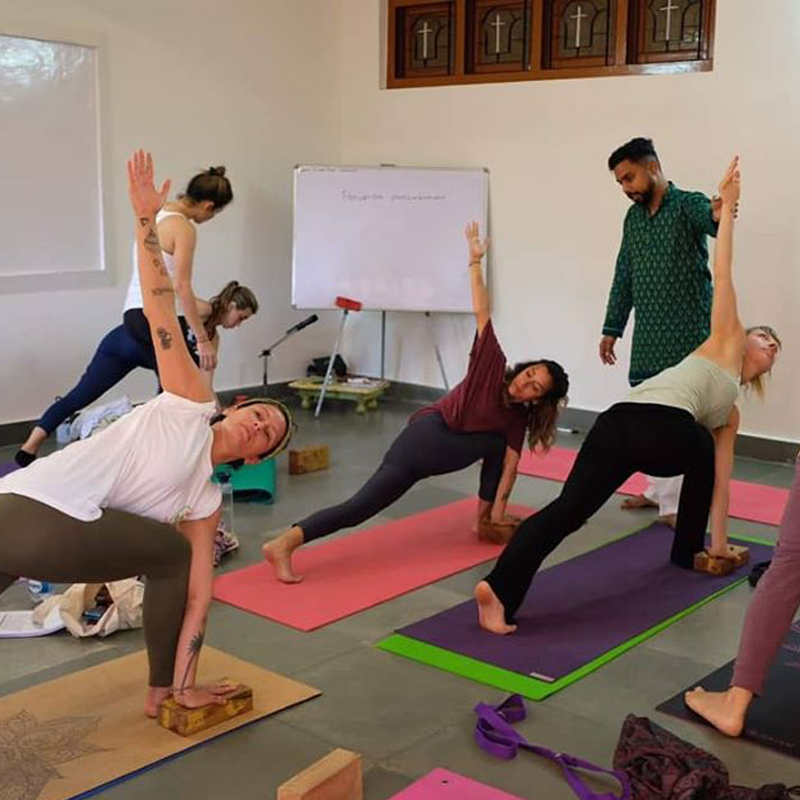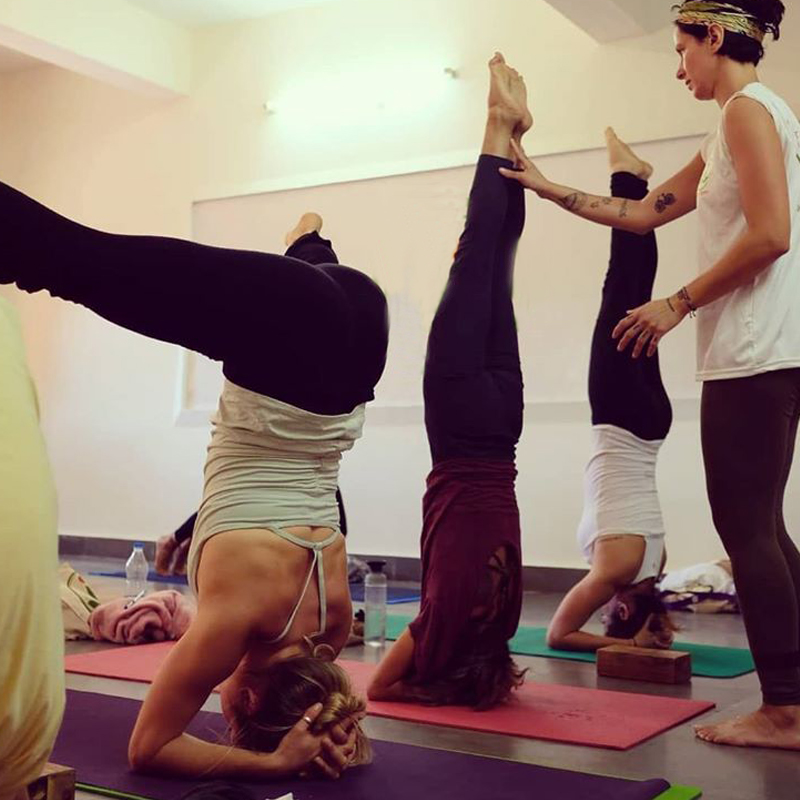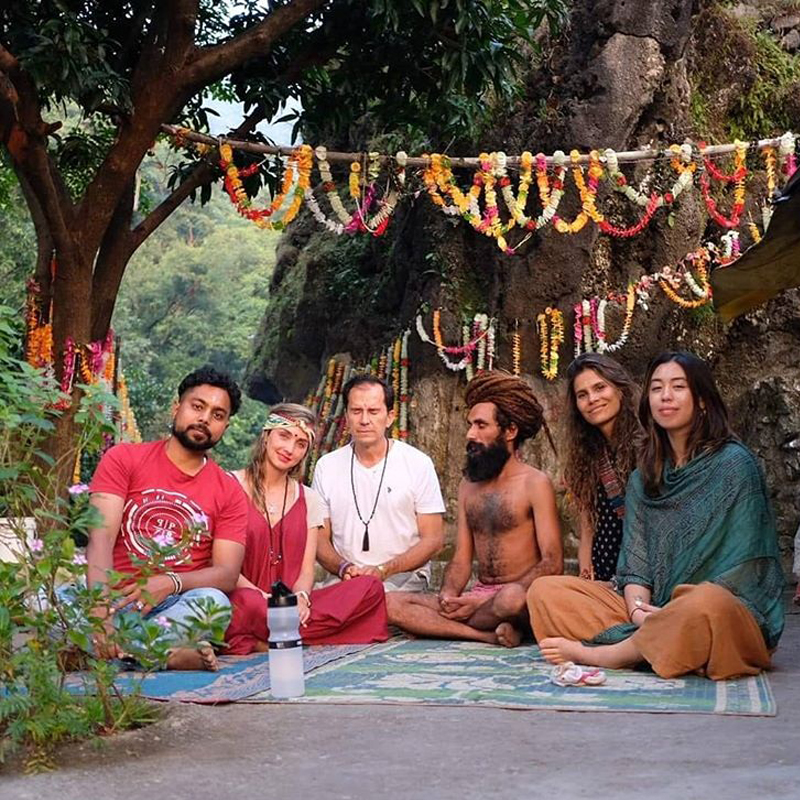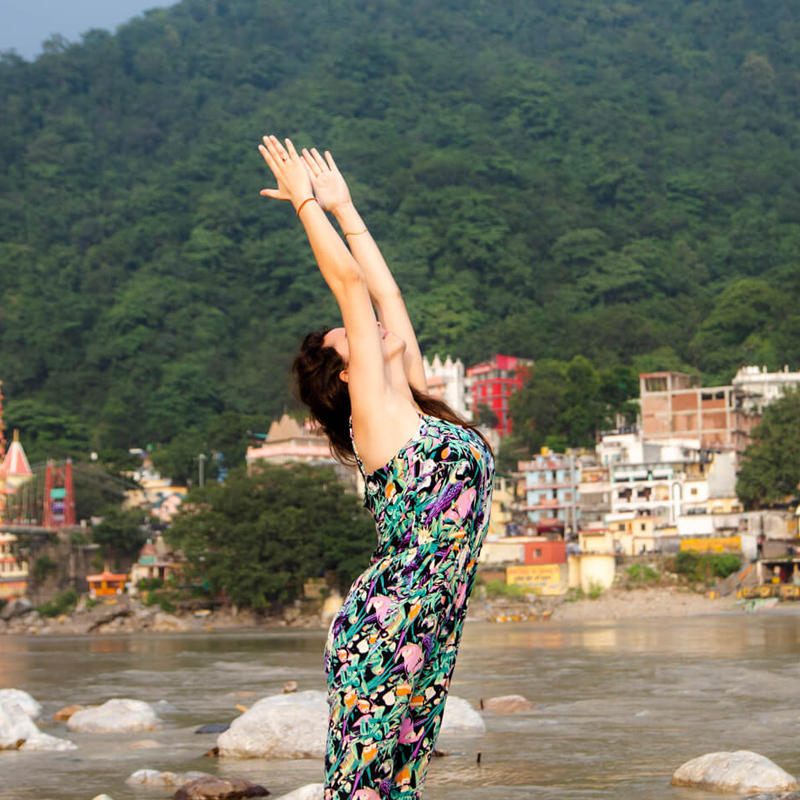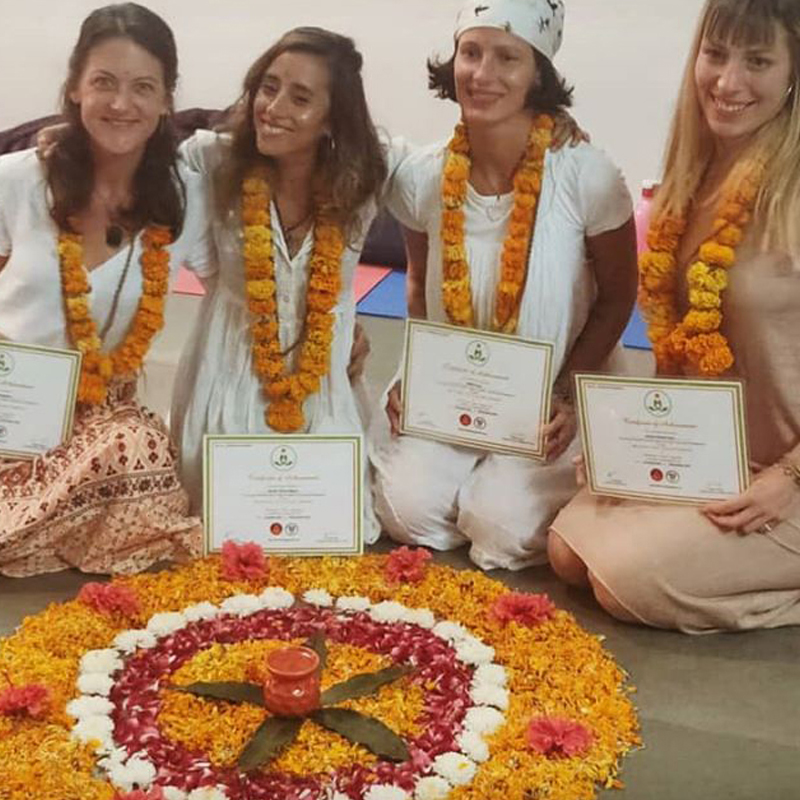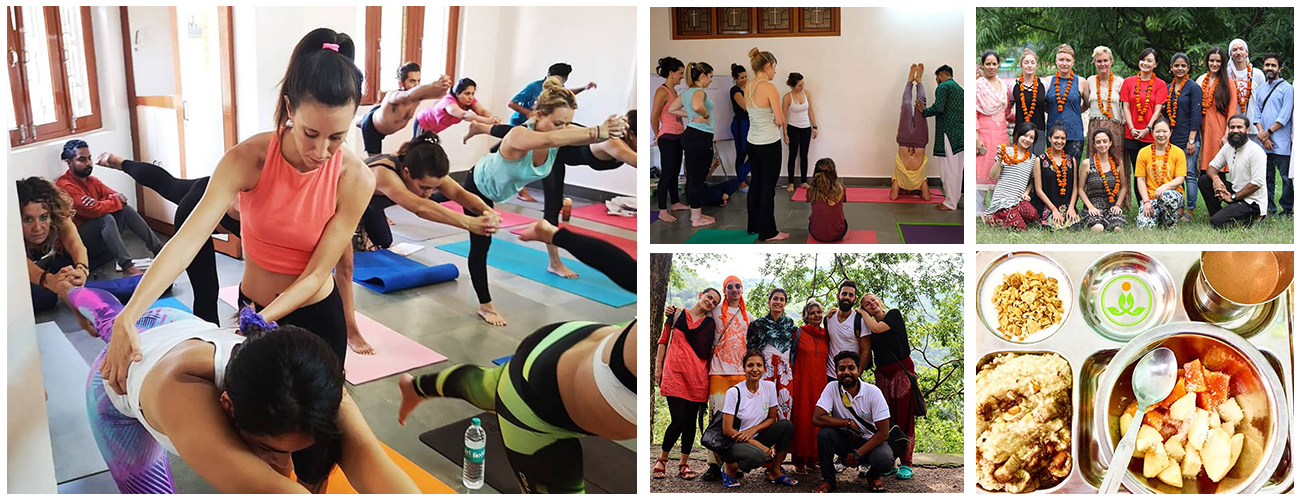
200 Hour Yoga Teacher Training In Rishikesh (Traditional Hatha-Vinyasa TTC Certification)
Overview - 200 Hour Yoga Teacher Training In Rishikesh (Traditional Hatha-Vinyasa TTC Certification)
With the aim of spreading the wisdom of Yoga and Spirituality for a divine cause, Rishikesh Yogis offers Yoga Alliance Accredited 200 Hour Hatha Vinyasa Yoga Training Certification to all the practicing yogis and yoga teaching aspirants in the globe. The program aims to foster a strong foundation with in-depth learning and practice that shall transform the aspiring yogis into full-fledged yoga instructors.
Have any question?
No money will be charged, feel free to enquire.
Images Gallery
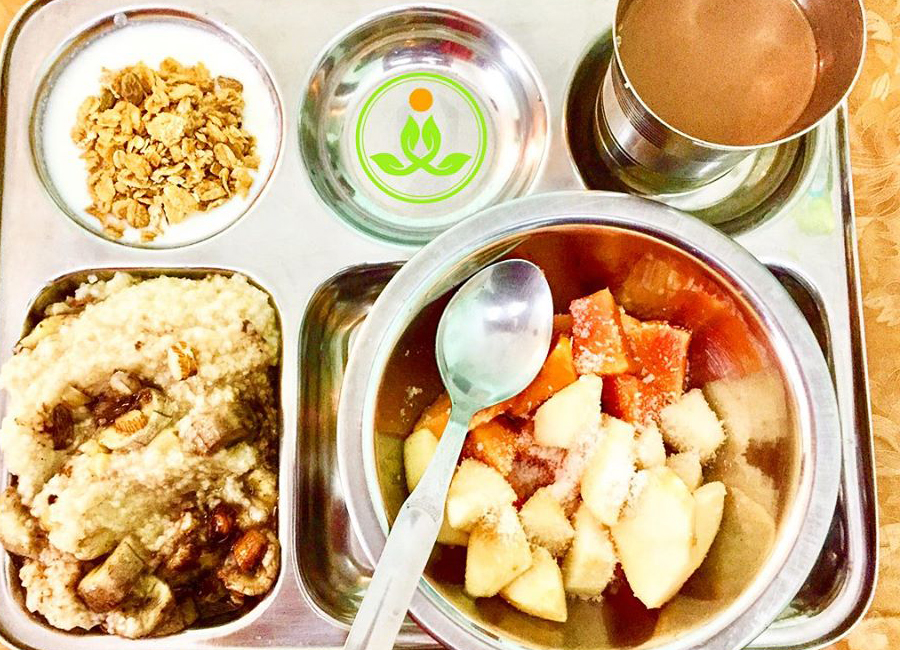

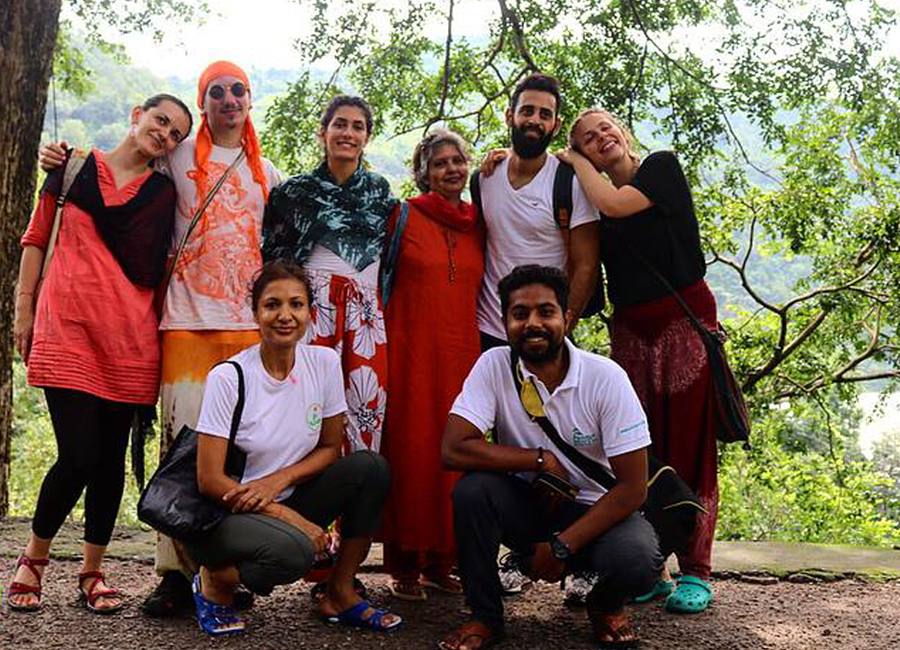
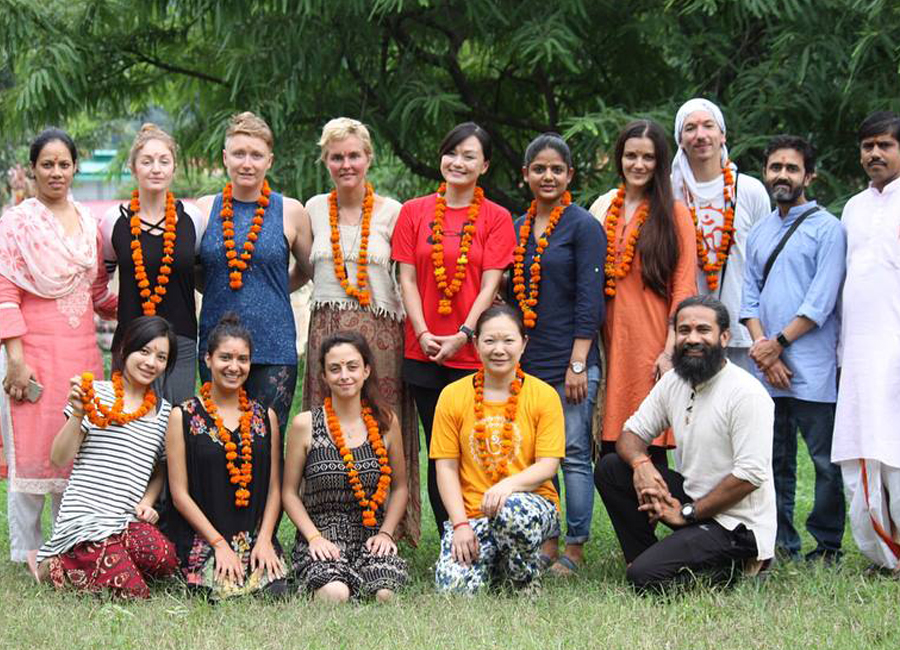
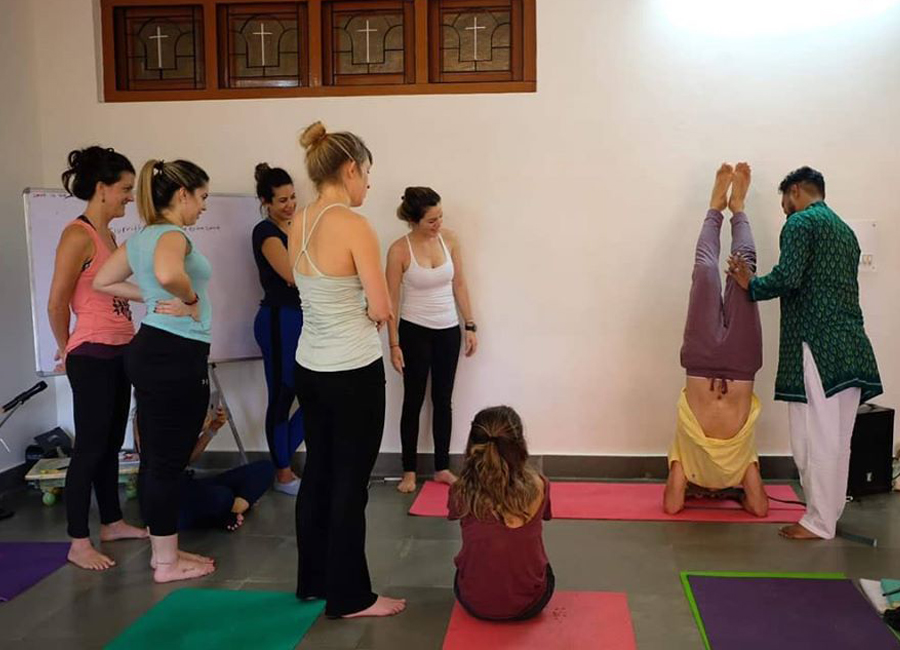
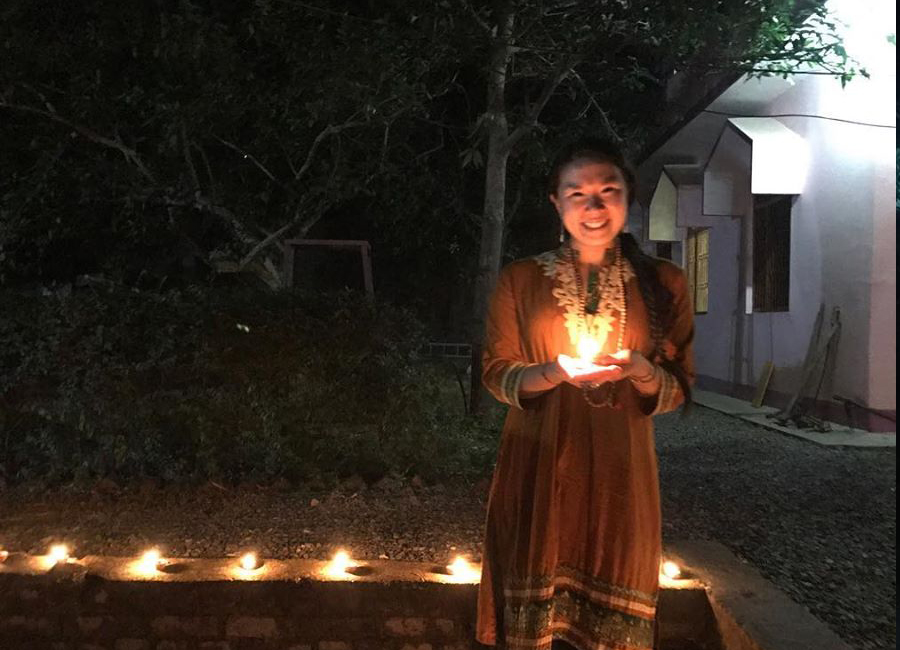
Program
- Course facilitated by a team of highly qualified and award-winning teachers in the field of Yoga teaching for more than 20 years.
- The entire course module is created to give a balanced exposure into the field of experiencing and teaching practical Hatha Yoga, traditional Meditations from Bihar School of Yoga, Shat kriyas (Cleansing methods in Hatha Yoga), Pranayama, Mudra and Bandha.
- There is in-depth theory discussions in our interactive sessions focusing on Samkhya Philosophy, Yoga Sutras of Patanjali, Traditional philosophy of Hatha Yoga and Kundalini Yoga.
- Mentoring the participants under the supervision of experienced teachers to conduct the classes on Hatha Yoga and various Meditation techniques.
- In-depth discussions on Anatomy and Physiology in light of Yoga practices and processes.
- Accommodation in one of the most traditional ashrams in Rishikesh.
- Opportunity to lead a yogic lifestyle in an ashram setting which is conducive for creating a stimulating setting for internalization and self-reflection and growth as a practitioner and teacher.
- Three vegetarian meals every day with Herbal tea.
Food & Accommodation
The ashram provides neat and clean rooms with attached washrooms. The rooms have proper ventilation and 24- hour power backup facilities. The ashram itself is located in a peaceful location away from the city which makes it a perfect location to practice yoga and meditation in peace.
Breakfast
Yoga school provide nourishing and balanced breakfast every day. Breakfast prepared in our kitchen is nutritious, tasty, balanced and prepared from fresh nuts, vegetables, fruits and grains. During your stay with us, you would have an opportunity to taste traditional Indian breakfast, such as different kinds of porridges, Idli (savoury cake), Poha (made from beaten rice), Upma (wheat rava (semolina) or coarse rice flour dish), Sprout salads, and many more. In case you are on vegan diet, we can prepare breakfast separately for you upon request.
Lunch
Food served at lunch is pure vegetarian, sattvik, vitalizing, wholesome and nutritious. The food prepared in our kitchen includes most vegetables, ghee (clarified butter), fruits, legumes, and whole grains. These are ingredients that enhance clarity and lightness, keeping the body light and nourished and the mind clear. Time to time during the course we change the nature of the food according to the yoga practices you perform.
Dinner is also served
Syllabus
The syllabus we have crafted for 200 Hour Yoga Teacher Training Course in Rishikesh, India is immersive and intensive for aspirants who want to delve deeper into the philosophy and practices of yoga. This course not only helps you understand the subject of yoga intellectually, but we intend to incorporate the principles of yogic philosophy in-class teaching which eventually helps both teacher and students to evolve at physical, mental and spiritual levels. the nuances of class teachings based on yogic principles and discussions on philosophical topics help streamline the approach and, experiences of yogic practices
Foundation
Paper I: Techniques, Training and Practice
Paper-1 (Technique, Training and Practice) lays a strong foundation of traditional Hatha Yoga, Vinyasa Yoga and Meditation techniques sourced from authentic and time-proven systems of Yoga traditions.
Purpose of these classes in component-1 is to equip the practitioners with understanding and knowledge of the fundamental techniques of Asana, Pranayama, Mudra, Bandha and Hatha Yoga Cleansing Techniques used in Traditional Hatha Yoga System.
Classes will incorporate practical demonstrations, understanding of correct positions, as well as practices of postures. Practices taught will focus on opening the joints and deepening the experiences of the asanas (postures) with breath consciousness and understanding of correct body alignment. Purpose of these practical classes is to awaken natural body intuition and awareness in the practitioners.
Training Modules:
Practical (Hatha Yoga)
Asana: Pawanmuktasana Series 1, 2, 3 (Preliminary Hatha yoga movements), Standing and Balancing Asana Series, Backward Bending Series, Forward Bending Series, Vajrasana Series, Meditation Asana Series, Introduction to Sun Salutation, Astanga-Vinyasa flow
Practical: Pranayama:
In Pranayama section, the objective is to introduce the concept of breathwork in Hatha Yoga System, different patterns of breathing in postures to enhance and deepen the effects of the postures and awareness in the practice. Component-1 incorporates techniques of Pre-Pranayama techniques from Asana and, various Mudras to enhance the awareness, as well as proficiency of the practitioners to breathe correctly.
Techniques Taught:
- Pranayama: Pre-Pranayama asanas and breathing techniques, three stages of breathing, Full yogic breathing, Nadi Shodhana pranayama, Bhramari, Kapalbhati, Ujjayi
- Mudra: Hand Mudras, Head Mudra, Prana Mudra with Full Yogic Breath (Awareness on the physical level)
- Bandha: Jalandhara Bandha
- Shatkriya: Jal Netland VamanDhauti (Kunjal Kriya)
Practical: Meditation
Through discussions and guided instruction, founding principles of meditation will be shared. In this component focus areas will be on sitting alignment, maintaining a correct meditation posture and systematic techniques of relaxation, such as Yoga Nidra and Ajapa Japa. The learning objective is to provide knowledge and understanding of appropriate tools to enhance awareness in meditation practices.
Techniques Taught:
- Kaya-Sthairyam (Technique on Body-Awareness and Mental steadiness)
- Antar Mouna (A technique on Mindfulness of Thoughts): Stages: 1, 2
- Ajapa Japa: (Awareness of spontaneous repetition of a mantra): Stages: 1, 2
- Yoga Nidra (A technique of guided yogic relaxation): Stage: Beginner
Paper-2: Yoga Philosophy, Lifestyle and Ethics for Yoga Teachers
Paper-2 in component-1 introduces one to founding principles of Yoga Philosophy, its branches, various approaches and affiliated metaphysical background. There is an in-depth discussion on systems of Indian Philosophical Traditions and Fundamentals of Samkhya Yoga Philosophy with reference to Classical System of Patanjali Raja Yoga.
Topics Taught:
- The philosophical foundation of Yoga
- Fundamentals of yogic philosophy in reference to Samkhya and classical system of Patanjali yoga. Definition, Historical Sketch, Branches
- Classical System of Raja Yoga of Patanjali: Background of Samkhya philosophy, History and origin of raja yoga, the philosophical background of raja yoga, the structure of the text (Patanjali yoga sutra), eight limbs of raja yoga, Discussion on important yoga sutras in light of yogic practices and processes.
Paper-3: Anatomy and Physiology
The Neuro-Musculoskeletal System –Focus of study will be based on studying different kinds of muscles, bones, joints and nervous system and, their roles in different yogic practices, such as Asana, Pranayama, Mudra and Bandhas.
The objective here will be given a fair understanding of different muscles, bones, joints, nervous system and brain organs and their location, functions and role in yogic practices. Special focus will be on how to enhance the proficiency of these organs with yogic techniques, safeguards in yogic practices to prevent any injuries to these organs and systems.
Topics Taught:
- Muscles; kinds of muscles, functions, effects of yogic practices on the muscular system.
- Skeletal system; functions of bones and various kinds of joints in yoga postures, the musculoskeletal system in yogic practice.
- The Nervous system: Functions of nervous system and brain (in light of yogic practices)
Level Intermediate
Paper I: Techniques, Training and Practice
Component-2 of the course entails an intermediate level of practices and understanding of the system of traditional Hatha Yoga. In this component, each paper helps to delve deeper into the knowledge and practices of Hatha Yoga.
Practical (Hatha Yoga)
Component-2 incorporates various ways of teaching Surya and Chandra Namaskar in the class incorporating breath and awareness of chakras. Sessions will be based on learning, as well as teaching asanas with body adjustments and knowledge of alignment. The focus of this component is to deepen the awareness of the practitioners in relation to the inner dynamics of postures, breathwork and cleansing of the mind-body system.
Techniques Taught:
Asana
Introducing the concept of Sadhana, Surya Namaskara: – Synchronizing breath and movement, dynamic, slow (breath in each posture), flowing continuous movement, Chandra Namaskara (focusing on the key elements of Chandra namaskar flow, rhythm etc with the breath), Vajrasana series, Standing series, Balancing series, Backward bending series, Forward Bending series, Twisting series, Inverted series, Meditation asana series.
Pranayama, Mudra, Bandha, Shatkriya
Through practical teaching and discussions, postural mudras, pranayama and bandhas will be introduced in classes. Discussions will also entail as how to incorporate bandhas and mudras in pranayama sessions.
Techniques Taught:
- Pranayama
- Nadishodhanapranayama with Kumbhaka, Kapalbhati and, Pre and Complete Bhastrika
- Mudra
- Category of Postural Mudras
- Bandha
- Mula bandha
- Shatkriya
- Laghoo Shankhaprakshalana (complete yogic intestinal wash), Kunjal and Neti
Practical (Meditation)
Techniques such as Trataka and Head Mudras will be taught to attune the awareness with Chidakasha (Head Space) for the purpose of effective Pratyahara (inner withdrawal of awareness). Other techniques of Pratyahara, such as Yoga Nidra, Ajapa Japa, Trataka and AntarMouna will be guided with a substantial focus on their psychotherapeutic benefits.
Techniques Taught:
- Antar Mouna: Stages: 1, 2, 3
- Trataka as Pratyahara
- Ajapa Japa: stage-3
- Yoga Nidra: Stage: Intermediate (Visualization of psychic passages, chakras)
- Guided instruction of chidakasha through a technique like Trataka, Head Mudras etc.
- As a Pratyahara technique, Trataka on Candle and Yantras will be done.
Paper-2: Yoga Philosophy, Lifestyle and Ethics for Yoga Teachers
The tradition of Hatha Yoga Historical and philosophical background, Literatures and Concept of Hatha yoga as in Hatha Yoga Pradipika and Gheranda Samhita. Aspects and purpose of Hatha Yoga and yogic lifestyle as per classical texts.
The tradition of Kundalini Yoga Tantras as the philosophical background of Kundalini Yoga, the concept of Kundalini. Concept of Chakras, their location and psycho-physical significance, method of Kundalini Sadhana, Effects of Kundalini Awakening
Paper-3: Anatomy and Physiology
The Respiratory and Cardiovascular system (in light of yogic breathing): This study will entail the structure and function of the respiratory and cardiovascular system in light of yogic practices such as Pranayama, Mudra and Bandhas. Discussions will focus on muscles of respiration, physiology of respiration and effects of different yogic breathing patterns on human physiology, effects of yogic practices on the cardiovascular system. The objective here is to deepen the understanding of respiratory and cardiovascular systems in relation to yogic practices of Pranayama, Mudra and Bandhas.
Topics Taught:
- Muscles of respiration, physiology of respiration and effects of different yogic breathing patterns on human physiology, effects of yogic practices on the cardiovascular system.
- The digestive system with reference to Asana, Pranayama and Shatkriya
- Yoga Anatomy: Intention of this topic is to present detailed information on the functioning and anatomy of the digestive system. Role of yogic practices on the vitality of the inner digestive organs and glands.
Paper-4: Teaching Methodology
Elements Of Effective Class Planning/Management: Focus of the module is to enhance the process of learning in the class through the application of effective planning and class management.
Topics Taught:
- Sessions on lesson planning, class progression and customizing sessions for various needs.
- Principles of effective demonstration, teaching styles to suit specific needs, student’s process of learning and ways to teach effectively in the class; Includes practise teaching, receiving feedback, observing others teaching and hearing/giving feedback.
- Preparation of the environment: shaucha (cleanliness), space, aroma, Students occupied, Interaction, Control Over the class; clarity of visibility and sound
Objective Is To Learn:
- How to plan the class for individual as well as group
- Understanding the needs of various groups while planning the session
- How to use demonstration for effective teaching
- Understanding verbal and non-verbal cues in class
Level Advance
Paper I: Techniques, Training and Practice
Practical (Hatha Yoga):
Through interactive discussions and practical sessions in the group concept of incorporating personal Sadhana in Hatha Yoga classes will be shared.
Students will be asked to choose a minimum one asana and pranayama with bandha to refine and deepen the experience. Introductory modules of Kriya Yoga will be introduced in the class; substantiated with both theory and practical teachings. Laghoo Shankhaprakshalana with Kunjal and Neti will be performed as part of Hatha yoga cleansing exercises.
Topics Taught:
- The focus of this component is to incorporate the different subtle and intense kriyas into one’s yoga program with insight and purpose to intensify the experiences of yogic practices.
- Group Work Assessment and Discussion: student teaching, as well as observing and assisting in classes taught by others — a combination of supervised and unsupervised.
- Expanding the idea of Sadhana in Hatha Yoga classes by incorporating personal Sadhana in Hatha Yoga to refine Hatha Yogic Postures.
Practical: Pranayama, Mudra, Bandha, Shatkriya
In Component-3 focus of the module will be to deepen the understanding of Kriya Yoga in light of Pranayama, Mudra and Bandha practices, experiencing Bandhas and Mudras with an awareness of chakras, practical teaching of Maha Bandha with head and postural mudras. Knowledge of chakras and nerve plexus in light of mudras and bandhas will be shared through active discussions. Principles of Kriyas and their energetic influence on the body-mind system will be discussed with reference to Pranayama, Mudra and Bandha practices.
Techniques Taught:
- Nadi shodhana, Kapalbhati, Bhramari, Bhastrika and Agnisar Kriya
- Mudra and Bandha
- Advanced pranayama with Maha Bandha, Moorcha Pranayama and other advanced Kriyas
- Introduction to Kriya Yoga- Vipreet-Karani Mudra, rotation of consciousness in the psychic pathways
Topics Taught:
- Incorporate Bandhas into Pranayama
- Advanced Pranayama with the Bandhas
- Introduction to Kriya Yoga
- Shatkriya.
Practical (Meditation)
Techniques such as Hridyakasha Dharana and its psychotherapeutic benefits in relation to the release of pent up emotions will be discussed and guided under supervision.
Intensive training on techniques of inner visualization in Yoga Nidra and Chidakasha will be provided.
Under the supervision of a trainer, in small groups, participants/students will be learning and teaching each other to assess, give and receive feedback on meditation instruction.
Techniques Taught:
- Techniques to channelize the feeling and emotions and, develop deeper understanding of one’s own self through techniques such as Hridyakasha Dharana.
- Group Work Assessment and Discussion: student teaching as well as observing and assisting in Classes taught by others.
- Yoga Nidra: stage: Advanced (Awareness of chakras, Tattvas and symbols)
- Trataka (As a Dharana Practice)
- Chakra Shuddhi (A technique of chakra cleansing)
- Chidakasha Dharana (A technique of inner visualization): Focus in Chidakasha through centering techniques, visualization of Yantra of Tattvas etc.
- Hridyakasha Dharana (Meditation to harmonize the heart space)
- Chakra Dharana-A
Paper-2: Yoga Philosophy, Lifestyle and Ethics for Yoga Teachers
Ethics of a Yoga Teacher (The Prerequisites): Here, we present the concept of Yogic life style for a sadhaka (Practitioner) and yoga teachers. Different ways to keep up the ethical values and philosophy as taught in the system of spiritual discipline, such as yoga. Introducing the concept of maintaining a spiritual dairy as part of personal Sadhana and Swadhyaya (self-study).
Topics Taught:
Ethics of yoga teachers, ‘living the Life of a Yogi’, teacher-student relationship; cautions and pitfalls, concept of Seva, Yogic life style: Concept of Sadhana for a teacher, Yoga as a life style, concept of spiritual diary etc.
Paper-3: Anatomy and Physiology
Yogic Physiology
The objective will be to develop insight and understanding of the subtle system of Nadis, Prana (energy channels), Vayus (Pranic currents), Chakras and Tattvas (elements) with reference to yogic techniques.
Topics Taught:
Structure of Pranic System: Concept of Prana, Nadis, Chakras, Prana Vayu, Pancha Tattvas and Pancha Kosha, classification of Prana Vayu, their functions and location in the body, role of Pranic system in life, importance of Prana, Nadis, Vayu, Chakras etc., in health and disease.
Paper-4: Teaching Methodology
Elements of an effective class presentation Purpose of this topic is to enhance the effectiveness of teacher in a class environment on the levels of presentation and delivery of the session. Discussion under this topic will incorporate methodologies to run the class in effective manner in order to facilitate an effective learning environment for the participants. Various aspects of class instructions and teaching methods will be discussed with proper demonstrations and discussions.
Topics Taught:
- Principles of Demonstration: Visibility, instruction while demonstration, clarity, coordination, quality of expressions,
- Assisting/Correction: Modes of correction (Group and individual)
- Orientation/Approach of the yoga sessions in group and personal classes; Use of modified variations of postures in the group, as well as personal sessions.
- Observation of verbal and non-verbal cues in class, ways to assist/correct the practitioners.
- Personal presentation: Dress, Confidence, Posture, Composure
- Balanced presentation: Time Management, Blend of practices and Order of practices
- Verbal presentation: Use of Language, Positive, Teacher’s Talk Time (TTT), Diction, Modulation, Clarity, Use of aids, Pause/Gaps of silence, Voice level (Volume), Suitability of the vocabulary
- Interaction with the Students/Practitioners: Awareness & Care of student’s well-being, Precautions, Benefits, Observation of students
- Coordination with other Depts. in the organization of Business aspects of teaching yoga: Yoga in Hospitality; health resorts and spas; Yoga in prison, yoga for army and police personnel, yoga in hospital; the role of yoga as a complimentary system/activity, practical limitations/challenges of yoga teachings in different environments
Marketing And Business Skills For Yoga Instructors
Topics Taught:
- Teaching Styles and Student Interactions Teaching Style: Developing your own teaching style, Different types of classes, Workshops and Private Sessions Student Engagement and Feedback: Becoming aware of your students, How to get feedback, Adaptation and Special population
- Internet Marketing and Social Media Website: Content, Social media connection, Blogging Social Media: Facebook business, Instagram tools, Creating and using videos Branding and other Marketing: Newsletter and Mail chimp
- Getting Started Where to Teach: Studio, Gym, Your own studio Finances and Insurance: Managing Finances and Taxes, Important of Insurance + how to get it.
Paper 5: Practicum
It will involve the delivery of yogic practices in a real class setting while following elements of effective class presentation and subsequently receiving and giving feedbacks.
Objective
The objective is to refine the teaching skill of the trainee as per the international standard of yoga teaching, applying the essentials of an effective class presentation.
Group work: Teaching in a small group, Giving and receiving feedback under the supervision of lead instructor; assessment of teaching on various parameters of class teaching
Use of aids (Visual and audio in the class) Preparing and conducting work-shops in a small group on chosen topics.
Included Excursions
- Walk to the Holy Ganges for Outdoor Meditation. Rejuvenate your body, mind and spirit in blessed water of the river.
- Guided excursions to sites of historical and yogic significance in the town (Rishikesh walks!)
- Visiting ancient meditation cave to experience its uplifting vibes!
What’s Included
- 1 complimentary Ayurvedic massage
- Accommodation (on single/sharing basis)
- Three meals and herbal infusions
- Guided Excursions
- Teaching supplements
What’s Not Included
- Airfare
- Personal Expenses
How to Get There
By Plane
The nearest International Airport from Rishikesh is the Indira Gandhi International Airport, New Delhi. Upon landing at the airport, you can avail a direct cab to the school. Alternatively, you can also ask the school to arrange a pick-up.
By Train
The nearest railway station is in Haridwar (Uttrakhand). You can book a direct train to this town. Upon reaching the station, you can either avail a cab for the ashram or, ask the ashram to arrange a pick-up.
By Bus
There are ample numbers of direct bus routes from various cities in the Northern part of India to Rishikesh. Upon reaching the bus stand in Rishikesh, you can take a rickshaw to the school. Alternatively, you can ask the school to arrange a pick-up.
Cancellation Policy
The reservation requires a payment of 20% of the total price.
- If the booking is cancelled one month (31 Days) prior to the start of the retreat/course you will get 90% refund of the booking amount.
- If the booking is cancelled 30 to 15 Days prior to the start of retreat/course, you will get 50% refund of the booking amount.
- No refund will be given if the retreat/course booking is cancelled less than 15 days prior to the start of the course. Although we can adjust the 50% of your paid amount to any other retreat/course you book with us in future.
The remaining amount shall be paid on arrival to the course/retreat location.
Teachers & Staff
Organizer


